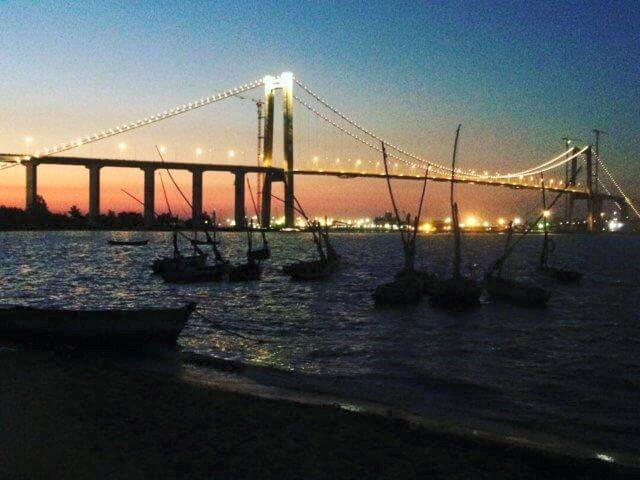Mozambique: Woman detained for stealing a newborn in Beira
Maputo Council will not tolerate informal selling on approaches to suspension bridge

Photo: Moz News
Maputo Municipal Council has warned that it will not tolerate informal markets springing up in the vicinity of new suspension bridge over the Bay of Maputo, linking the centre of the capital to the outlying municipal district of Katembe.
Within a day or two of the inauguration of the bridge last Saturday, informal vendors began hawking their wares at the side of the access ramps to the bridge.
In response, the council issued a statement on Wednesday warning that such informal markets are absolutely banned in the vicinity of the bridge. No-one may sell any goods within a strip of 50 metres either side of the approach roads.
The statement also warned against people taking shelter or building anything under the bridge. Users of the bridge must not entertain themselves by clambering onto the railings, as several people, some of them apparently inebriated, did on Sunday.
The statement, issued jointly by the Council, by the company operating the bridge, Maputo-Sul, and by Mozambican Railways (CFM), urged citizens to follow these rules voluntarily – anyone who chose not to could expect severe measures. And on Wednesday afternoon, since there were still people selling near the bridge, the Municipal Police swooped, and seized all their goods.
According to a report on the independent television station STV, many of the sellers used to be stallholders in the Nwankakana informal market which had to be removed to build the ramp onto the northern access road to the bridge.
Nwankakana had a disreputable history going back to the 1980s, when it was a place that sold goods stolen from the nearby port of Maputo. But the municipal council tolerated the existence of this market until, last year, it became a major obstacle to building the bridge.
The stallholders demanded compensation, and eventually the Council and Maputo-Sul caved in to their demands and paid compensation of up to 300,000 meticais (5,000 US dollars) for their flimsy stalls. They were also given space in a new municipal market.
Their refusal to move held up completion of the northern access road and was the main reason why the inauguration of the bridge was almost a year behind schedule.
And now, they have come back. One of the informal sellers, named only as Amelia, said “we live in Mozambique, we’re children of Mozambique, we’re fighting so that our children can go to school and have enough to eat. But they’re throwing us out of here. Where shall we go?”
‘Informal market’ rising in the shadow of the new Mapto-Katembe bridge – Watch https://t.co/Kb7VLm67wl #Mozambique pic.twitter.com/FXAV6gWJ2P
— Club of Mozambique (@clubOmozambique) November 14, 2018
Maputo-Catembe bridge: Agreement with Nwankakana stallholders reached https://t.co/JbK8IDnW7Y #Mozambique pic.twitter.com/YyxSpdlTl3
— Club of Mozambique (@clubOmozambique) December 11, 2017
These sellers did not want to use the municipal market, claiming it was “like a morgue. Nobody talks to us and we don’t sell anything”, said Amelia. “Our goods just rot. That why we left”.
Another former Nwankakana stallholder, named Zita, said the sellers will not leave the vicinity of the bridge because not enough stalls had been provided in the municipal market.
For many years the Municipal Council has tried to move informal vendors off the streets and into the markets. It has been unsuccessful, no doubt because the vendors know that once they are in the markets, they will have to pay taxes to the Council. The taxes are much more difficult to collect from itinerant sellers, than from people with fixed market stalls.
The Council has warned that this time it will not yield, because the bridge and its approach roads are public assets which require the highest level of protection, preservation and maintenance.
Residentes da #KaTembe atravessam a #ponte caminhando alegadamente porque os transporte marítimo que outrora usam opera agora até 18/19h e não há os prometidos “chapas” que lhes transporte para suas residências. pic.twitter.com/7NJhWDjMG9
— Mussa Chaleque (@MChaleque) November 15, 2018
Meanwhile, as expected, the bridge has dealt a blow to the ferries that were previously the only way to make the crossing between Maputo and Katembe. The largest ferry is operated by the state company Transmaritima, and the bottom has now fallen out of its business.
Despite all the grumbling about the tolls on the bridge, they are cheaper than the prices charged for the ferry service. The toll for a light vehicle to drive over the bridge is 160 meticais. The ferry charges 250 meticais on a weekday and 300 meticais at weekends.
Pedestrians, however, continue to use boats to make the crossing. There is no pedestrian walkway on the bridge, and the timetables for buses of the municipal transport company, EMTPM, crossing the bridge have not yet been published.
So some pedestrians continue to cross the Bay by boat. Two of the small boats that carry passengers between Maputo and Katembe, the “Mapapai” and “Transportes Boa Viagem”, have even cut their fares by a third, from 15 to ten meticais. Freddy Miranda, the owner of “Boa Viagem” said this was a reaction to the opening of the bridge which, he feared, could “kill off” maritime transport.
He said his business might become unsustainable, and claimed that his boats use 300 litres of diesel a day.
EMTPM is now running routes from Katembe across the bridge to various parts of Maputo for the flat fare of 12 meticais.












Leave a Reply
Be the First to Comment!
You must be logged in to post a comment.
You must be logged in to post a comment.